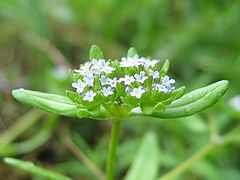Valerianella: Difference between revisions
Created page with '{{SPlantbox |Min ht metric=cm |Temp Metric=°F |image=Upload.png |image_width=240 }} {{Inc| Valerianella (diminutive of Valeriana). Valerianaceae. Annual dichotomously branched h…' |
No edit summary |
||
| Line 2: | Line 2: | ||
|Min ht metric=cm | |Min ht metric=cm | ||
|Temp Metric=°F | |Temp Metric=°F | ||
|image= | |image=Valerianella locusta.jpeg | ||
|image_width=240 | |image_width=240 | ||
|image_caption=Valerianella locusta | |||
}} | }} | ||
'''''Valerianella''''' is a genus of [[plant]] in family [[Valerianaceae]]. | |||
{{Inc| | {{Inc| | ||
Valerianella (diminutive of Valeriana). Valerianaceae. Annual dichotomously branched herbs, chiefly spring plants, sometimes planted in wild-garden or rock-garden; one is a salad plant. | Valerianella (diminutive of Valeriana). Valerianaceae. Annual dichotomously branched herbs, chiefly spring plants, sometimes planted in wild-garden or rock-garden; one is a salad plant. | ||
| Line 10: | Line 13: | ||
Leaves, lower, in a radical rosette, entire; cauline entire, dentate or rarely incise-pinnatifid: cymes sometimes corymbosely paniculate fastigiate, sometimes densely globose at the ends of the branches: fls. whitish, pale bluish, or rose; corolla-tube short or rarely elongate, limb 5-cleft, spreading; stamens 3: fr. 3-celled, 2 of which are empty.—About 58 species, Eu., N. Afr., W. Asia, and N. Amer., mostly in the Medit. region. | Leaves, lower, in a radical rosette, entire; cauline entire, dentate or rarely incise-pinnatifid: cymes sometimes corymbosely paniculate fastigiate, sometimes densely globose at the ends of the branches: fls. whitish, pale bluish, or rose; corolla-tube short or rarely elongate, limb 5-cleft, spreading; stamens 3: fr. 3-celled, 2 of which are empty.—About 58 species, Eu., N. Afr., W. Asia, and N. Amer., mostly in the Medit. region. | ||
Corn salad is both a salad plant and a pot-herb, chiefly the former. The name "corn salad" is probably derived from the fact that the plant grows spontaneously in the grain-fields of Europe, large quantities of it being gathered in early spring. It is rather tasteless compared with lettuce, and is little known in America. Abroad it is prized as a fall and winter salad. It is a cool-season crop, grown like lettuce and matures in six to eight weeks. Plants should stand about 6 inches apart in the row. An ounce of seed should give 2,000 to 3,000 plants | Corn salad is both a salad plant and a pot-herb, chiefly the former. The name "corn salad" is probably derived from the fact that the plant grows spontaneously in the grain-fields of Europe, large quantities of it being gathered in early spring. It is rather tasteless compared with lettuce, and is little known in America. Abroad it is prized as a fall and winter salad. It is a cool-season crop, grown like lettuce and matures in six to eight weeks. Plants should stand about 6 inches apart in the row. An ounce of seed should give 2,000 to 3,000 plants. | ||
}} | }} | ||
| Line 17: | Line 20: | ||
===Propagation=== | ===Propagation=== | ||
Sow seed in early spring to late summer, where the plants are to grow. | |||
===Pests and diseases=== | ===Pests and diseases=== | ||
| Line 23: | Line 26: | ||
==Species== | ==Species== | ||
Here is an incomplete list of its species: | |||
* ''[[Valerianella affinis]]'', [[Isaac Bayley Balfour|Balf.f.]] Yemenite Mache (believed extinct) | |||
* ''[[Valerianella locusta]]'', Corn Salad or Lamb's Lettuce | |||
* ''[[Valerianella ozarkana]]'', Ozark Corn Salad | |||
* ''[[Valerianella eriocarpa]]'', Fetticus (considered by some to be merely a subspecies of ''V. locusta'') | |||
* ''[[Valerianella radiata]] | |||
==Gallery== | ==Gallery== | ||
Latest revision as of 17:50, 4 July 2010
| subsp. var. | ||||||||||||||||||||||||||||||||||||||||||||||||||||||||
|---|---|---|---|---|---|---|---|---|---|---|---|---|---|---|---|---|---|---|---|---|---|---|---|---|---|---|---|---|---|---|---|---|---|---|---|---|---|---|---|---|---|---|---|---|---|---|---|---|---|---|---|---|---|---|---|---|

|
|
| ||||||||||||||||||||||||||||||||||||||||||||||||||||||
| ||||||||||||||||||||||||||||||||||||||||||||||||||||||||
Valerianella is a genus of plant in family Valerianaceae.
| Standard Cyclopedia of Horticulture |
|---|
|
Valerianella (diminutive of Valeriana). Valerianaceae. Annual dichotomously branched herbs, chiefly spring plants, sometimes planted in wild-garden or rock-garden; one is a salad plant. Leaves, lower, in a radical rosette, entire; cauline entire, dentate or rarely incise-pinnatifid: cymes sometimes corymbosely paniculate fastigiate, sometimes densely globose at the ends of the branches: fls. whitish, pale bluish, or rose; corolla-tube short or rarely elongate, limb 5-cleft, spreading; stamens 3: fr. 3-celled, 2 of which are empty.—About 58 species, Eu., N. Afr., W. Asia, and N. Amer., mostly in the Medit. region. Corn salad is both a salad plant and a pot-herb, chiefly the former. The name "corn salad" is probably derived from the fact that the plant grows spontaneously in the grain-fields of Europe, large quantities of it being gathered in early spring. It is rather tasteless compared with lettuce, and is little known in America. Abroad it is prized as a fall and winter salad. It is a cool-season crop, grown like lettuce and matures in six to eight weeks. Plants should stand about 6 inches apart in the row. An ounce of seed should give 2,000 to 3,000 plants.
|
Cultivation
Propagation
Sow seed in early spring to late summer, where the plants are to grow.
Pests and diseases
Species
Here is an incomplete list of its species:
- Valerianella affinis, Balf.f. Yemenite Mache (believed extinct)
- Valerianella locusta, Corn Salad or Lamb's Lettuce
- Valerianella ozarkana, Ozark Corn Salad
- Valerianella eriocarpa, Fetticus (considered by some to be merely a subspecies of V. locusta)
- Valerianella radiata
Gallery
If you have a photo of this plant, please upload it! Plus, there may be other photos available for you to add.
-
photo 1
-
photo 2
-
photo 3
References
- Standard Cyclopedia of Horticulture, by L. H. Bailey, MacMillan Co., 1963
External links
- w:Valerianella. Some of the material on this page may be from Wikipedia, under the Creative Commons license.
- Valerianella QR Code (Size 50, 100, 200, 500)
